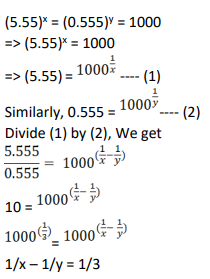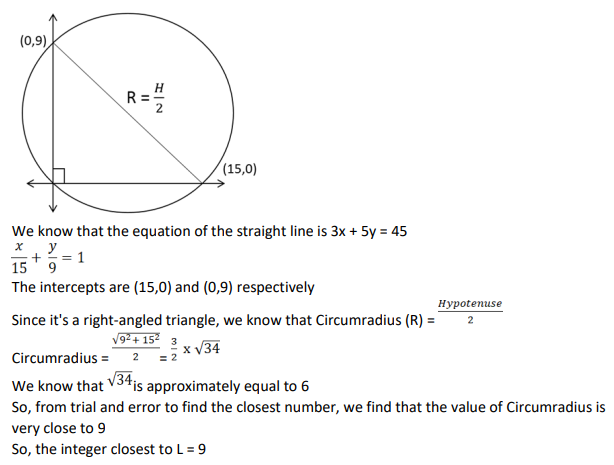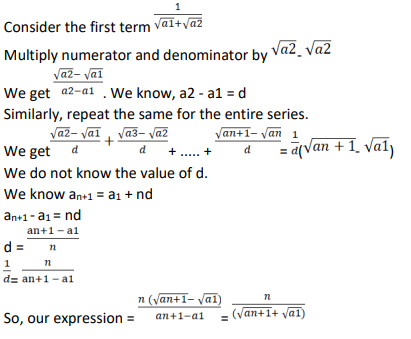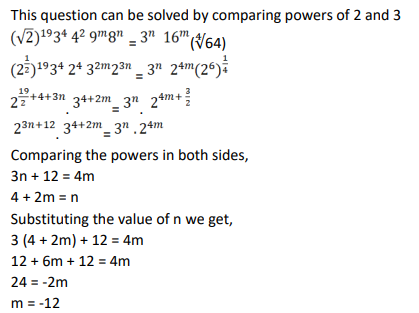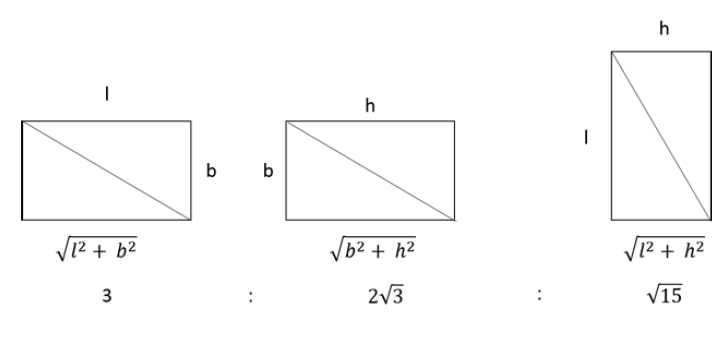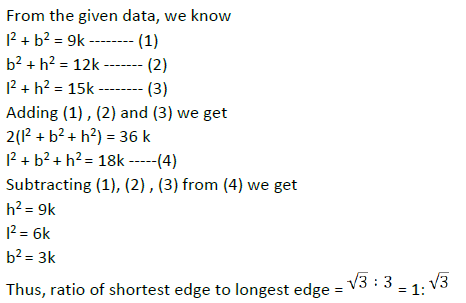Live Updates
• CATKing has launched new chat bot.

• New video on Logs has been released.
495
Learners
asked the doubt

Previous Year Questions
Tale of Aladdin
In the past, credit for telling the tale of Aladdin has often gone to Antoine Galland . . . the first European translator of . . . Arabian Nights [which] started as a series of translations of an incomplete manuscript of a medieval Arabic story collection. . . But, though those tales were of medieval origin, Aladdin may be a more recent invention. Scholars have not found a manuscript of the story that predates the version published in 1712 by Galland, who wrote in his diary that he first heard the tale from a Syrian storyteller from Aleppo named Hanna Diyab . . .
Despite the fantastical elements of the story, scholars now think the main character may actually be based on a real person’s real experiences. . . . Though Galland never credited Diyab in his published translations of the Arabian Nights stories, Diyab wrote something of his own: a travelogue penned in the mid-18th century. In it, he recalls telling Galland the story of Aladdin [and] describes his own hard-knocks upbringing and the way he marveled at the extravagance of Versailles. The descriptions he uses were very similar to the descriptions of the lavish palace that ended up in Galland’s version of the Aladdin story. [Therefore, author Paulo Lemos] Horta believes that “Aladdin might be the young Arab Maronite from Aleppo, marveling at the jewels and riches of Versailles.” . . .
For 300 years, scholars thought that the rags-to-riches story of Aladdin might have been inspired by the plots of French fairy tales that came out around the same time, or that the story was invented in that 18th century period as a byproduct of French Orientalism, a fascination with stereotypical exotic Middle Eastern luxuries that was prevalent then. The idea that Diyab might have based it on his own life — the experiences of a Middle Eastern man encountering the French, not vice-versa — flips the script. [According to Horta,] “Diyab was ideally placed to embody the overlapping world of East and West, blending the storytelling traditions of his homeland with his youthful observations of the wonder of 18th-century France.” . . .
To the scholars who study the tale, its narrative drama isn’t the only reason storytellers keep finding reason to return to Aladdin. It reflects not only “a history of the French and the Middle East, but also [a story about] Middle Easterners coming to Paris and that speaks to our world today,” as Horta puts it. “The day Diyab told the story of Aladdin to Galland, there were riots due to food shortages during the winter and spring of 1708 to 1709, and Diyab was sensitive to those people in a way that Galland is not. When you read this diary, you see this solidarity among the Arabs who were in Paris at the time. . . . There is little in the writings of Galland that would suggest that he was capable of developing a character like Aladdin with sympathy, but Diyab’s memoir reveals a narrator adept at capturing the distinctive psychology of a young protagonist, as well as recognizing the kinds of injustices and opportunities that can transform the path of any youthful adventurer.”
The author of the passage is most likely to agree with which of the following explanations for the origins of the story of Aladdin?
Video Explanation

Explanatory Answer
The passage clearly states that Diyab himself narrated the story of Aladdin to Galland (who wrote the Arabian Nights) and argues that Diyab might have based it on his own life. So, option 3 is the correct option.
Option 1 suggests that Galland simply derived the story from Diyab's travelogue (as opposed to hearing it from Diyab himself). This is incorrect. The passage argues the story of Aladdin is based on Diyab's own life, so options 2 and 4 are incorrect.
Which of the following, if true, would invalidate the inversion that the phrase “flips the script” refers to?
Video Explanation

Explanatory Answer
Diyab's descriptions of grandeur of Versailles match the description of the lavish Middle Eastern palace in Aladdin's story. That is, Galland simply takes up Diyab’s description of a French palace and pins this description on an exotic Middle Eastern palace in the story of Aladdin. That the opulence described is not one witnessed by a French adventurer encountering the exotic Middle East but that of a Middle Eastern observer encountering the wonder of 18th century France is what 'flips the script' (reverses the situation) according to the passage. If the descriptions did not match, there is no question of the script being flipped. So, option 3, if true, would invalidate the idea that Galland's story reverses the point of view of the narrative.
Which of the following is the primary reason for why storytellers are still fascinated by the story of Aladdin?
Video Explanation

Explanatory Answer
In the last paragraph, the passage argues that the reason why storytellers are still fascinated by the story of Aladdin is not just because of the story’s narrative drama or the way it reflects the history of the French and the Middle East, but because it is a story about ‘Middle Easterners coming to Paris and that speaks to our world today’. In other words, the tale of Aladdin resonates even today.
Which of the following does not contribute to the passage’s claim about the authorship of Aladdin?
Video Explanation

Explanatory Answer
In paragraph 3, the passage states that though scholars thought for many years that the story line of Aladdin was inspired by plots of French fairy tales of the time, the evidence suggesting that Diyab based the story on his own life flips the script. This was a story of a young Arab in France, not the other way around.
The passage supports its claim about the authorship of Aladdin citing the narrative sensibility of Diyab's travelogue ('There is little in the writings of Galland that would suggest that he was capable of developing a character like Aladdin with sympathy, but Diyab’s memoir reveals a narrator adept at capturing the distinctive psychology of a young protagonist...'), the depiction of the affluence of Versailles in Diyab's travelogue ('The descriptions he uses were very similar to the descriptions of the lavish palace that ended up in Galland’s version of the Aladdin story') and Galland's acknowledgement of Diyab in his diary (' Galland... wrote in his diary that he first heard the tale from a Syrian storyteller from Aleppo named Hanna Diyab).
Choice Fatigue
Contemporary internet shopping conjures a perfect storm of choice anxiety. Research has consistently held that people who are presented with a few options make better, easier decisions than those presented with many. . . . Helping consumers figure out what to buy amid an endless sea of choice online has become a cottage industry unto itself. Many brands and retailers now wield marketing buzzwords such as curation, differentiation, and discovery as they attempt to sell an assortment of stuff targeted to their ideal customer. Companies find such shoppers through the data gold mine of digital advertising, which can catalog people by gender, income level, personal interests, and more. Since Americans have lost the ability to sort through the sheer volume of the consumer choices available to them, a ghost now has to be in the retail machine, whether it’s an algorithm, an influencer, or some snazzy ad tech to help a product follow you around the internet. Indeed, choice fatigue is one reason so many people gravitate toward lifestyle influencers on Instagram—the relentlessly chic young moms and perpetually vacationing 20-somethings—who present an aspirational worldview, and then recommend the products and services that help achieve it. . . .
For a relatively new class of consumer-products start-ups, there’s another method entirely. Instead of making sense of a sea of existing stuff, these companies claim to disrupt stuff as Americans know it. Casper (mattresses), Glossier (makeup), Away (suitcases), and many others have sprouted up to offer consumers freedom from choice: The companies have a few aesthetically pleasing and supposedly highly functional options, usually at mid-range prices. They’re selling nice things, but maybe more importantly, they’re selling a confidence in those things, and an ability to opt out of the stuff rat race. . . .
One-thousand-dollar mattresses and $300 suitcases might solve choice anxiety for a certain tier of consumer, but the companies that sell them, along with those that attempt to massage the larger stuff economy into something navigable, are still just working within a consumer market that’s broken in systemic ways. The presence of so much stuff in America might be more valuable if it were more evenly distributed, but stuff’s creators tend to focus their energy on those who already have plenty. As options have expanded for people with disposable income, the opportunity to buy even basic things such as fresh food or quality diapers has contracted for much of America’s lower classes.
For start-ups that promise accessible simplicity, their very structure still might eventually push them toward overwhelming variety. Most of these companies are based on hundreds of millions of dollars of venture capital, the investors of which tend to expect a steep growth rate that can’t be achieved by selling one great mattress or one great sneaker. Casper has expanded into bedroom furniture and bed linens. Glossier, after years of marketing itself as no-makeup makeup that requires little skill to apply, recently launched a full line of glittering color cosmetics. There may be no way to opt out of stuff by buying into the right thing.
Which of the following hypothetical statements would add the least depth to the author’s prediction of the fate of start-ups offering few product options?
Video Explanation

Explanatory Answer
The question asks us to choose the statement that, if true, would add the least depth to the author's prediction about start-ups. That is, we need to choose the option which goes against the author's prediction.
What is the author’s prediction about start-ups offering few product options? He predicts that these start-ups would be forced to offer variety due to the steep growth expectations of investors. That is, profit motive drives the push towards new product options. If start-ups are able to meet the desired profit goals without expanding their product range, then the author's prediction is no longer valid. So, option 1 is a possible answer choice.
Consider option 2. If the government doubles tax for these start-ups, the pressure on them to make a profit increases. This actually supports the author's prediction. So, it is ruled out.
If option 3 is true, that is, if regular customers of these start-ups lose trust in them, sales will decline and hence there would be more pressure on them to expand their range to make profit. This option too supports the author's prediction.
That start-ups with few product options are 'still just working within a consumer market that’s broken in systemic ways' is an argument used by the author to make his point about the narrowness of choice for certain consumer segments. This does not in any way go against the author's prediction about these start-ups being forced to expand their product range.
So, the option that adds least depth—goes against—the author's prediction is option 1.
Which one of the following best sums up the overall purpose of the examples of Casper and Glossier in the passage?
Video Explanation

Explanatory Answer
The author first cites the examples of Casper and Glossier while discussing companies that 'have sprouted up to offer consumers freedom from choice'. That is, they are exceptions to the dominant trend of flooding consumers with choice. However, the author does not leave it at that. He argues that even these start-ups promising simplicity of choice will be pushed toward overwhelming variety due to the steep growth expectations from investors. That is, though they are exceptions now, Casper and Glossier may transform into what they are exceptions to.
A new food brand plans to launch a series of products in the American market. Which of the following product plans is most likely to be supported by the author of the passage?
Video Explanation

Explanatory Answer
Consider what the author says about the consumer market in America: ‘The presence of so much stuff in America might be more valuable if it were more evenly distributed..... As options have expanded for people with disposable income, the opportunity to buy even basic things such as fresh food or quality diapers has contracted for much of America’s lower classes.’
The author is likely to support the introduction of more choice in a price range catering to the lower classes. So, we narrow down the answer options to 1 and 3, which are in the $5 and $10 range. Of these two options, the author is more likely to support the range of 10 products than the range of 25 products, as he argues in the passage that more choice means choice fatigue.
All of the following, IF TRUE, would weaken the author’s claims EXCEPT:
Video Explanation

Explanatory Answer
The question asks us to choose the option that would not weaken the author's claims.
Consider option 1. The author claims that 'the presence of so much stuff in America might be more valuable if it were more evenly distributed, but stuff’s creators tend to focus their energy on those who already have plenty'. That is, product choice for higher income groups does not really benefit the poor. But if product options increased market competition, bringing down the prices of commodities, which, in turn, increased purchasing power of the poor, then the author's claim is weakened.
Option 2 relates to sales growth of companies with fewer product options. The author claims that people when presented with a few options make better, easier decisions than when presented with many. So, if the annual sales growth of companies with fewer product options were higher than that of companies which curated their products for target consumers, then the author's claim is actually strengthened.
Consider option 3. The author claims that choice fatigue is the reason why people gravitate toward lifestyle influencers on Instagram. If the annual sale of companies that hired lifestyle influencers on Instagram for marketing their products were 40% less than those that did not, then the author's claim is weakened.
Consider option 4. The author states that 'research has consistently held that people who are presented with a few options make better, easier decisions than those presented with many'. But if the empowerment felt by purchasers in buying a commodity were directly proportional to the number of options they could choose from, it would weaken author's claim.
Based on the passage, all of the following can be inferred about consumer behaviour EXCEPT that:
Video Explanation

Explanatory Answer
The question asks us to choose the answer option that cannot be inferred from the passage.
Option 1 states that ‘too many options have made it difficult for consumers to trust products’. This is clearly inferred from the passage, which talks of consumer ‘choice anxiety’ and describes companies with limited product options as ‘selling nice things, but maybe more importantly, they’re selling a confidence in those things, and an ability to opt out of the stuff rat race’.
Option 2 states that ‘consumers are susceptible to marketing images that they see on social media.’ This too, is mentioned in the passage: ‘Indeed, choice fatigue is one reason so many people gravitate toward lifestyle influencers on Instagram...’
Option 3 says that ‘having too many product options can be overwhelming for consumers’. This relates to ‘choice anxiety’ described in the passage.
Only option 4 – that consumers tend to prefer products by start-ups over those by established companies—is not inferred from the passage.
Emperor Penguins
Scientists recently discovered that Emperor Penguins—one of Antarctica’s most celebrated species—employ a particularly unusual technique for surviving the daily chill. As detailed in an article published today in the journal Biology Letters, the birds minimize heat loss by keeping the outer surface of their plumage below the temperature of the surrounding air. At the same time, the penguins’ thick plumage insulates their body and keeps it toasty. . . .
The researchers analyzed thermographic images . . . taken over roughly a month during June 2008. During that period, the average air temperature was 0.32 degrees Fahrenheit. At the same time, the majority of the plumage covering the penguins’ bodies was even colder: the surface of their warmest body part, their feet, was an average 1.76 degrees Fahrenheit, but the plumage on their heads, chests and backs were -1.84, -7.24 and -9.76 degrees Fahrenheit respectively. Overall, nearly the entire outer surface of the penguins’ bodies was below freezing at all times, except for their eyes and beaks. The scientists also used a computer simulation to determine how much heat was lost or gained from each part of the body—and discovered that by keeping their outer surface below air temperature, the birds might paradoxically be able to draw very slight amounts of heat from the air around them. The key to their trick is the difference between two different types of heat transfer: radiation and convection.
The penguins do lose internal body heat to the surrounding air through thermal radiation, just as our bodies do on a cold day. Because their bodies (but not surface plumage) are warmer than the surrounding air, heat gradually radiates outward over time, moving from a warmer material to a colder one. To maintain body temperature while losing heat, penguins, like all warm-blooded animals, rely on the metabolism of food. The penguins, though, have an additional strategy. Since their outer plumage is even colder than the air, the simulation showed that they might gain back a little of this heat through thermal convection—the transfer of heat via the movement of a fluid (in this case, the air). As the cold Antarctic air cycles around their bodies, slightly warmer air comes into contact with the plumage and donates minute amounts of heat back to the penguins, then cycles away at a slightly colder temperature.
Most of this heat, the researchers note, probably doesn’t make it all the way through the plumage and back to the penguins’ bodies, but it could make a slight difference. At the very least, the method by which a penguin’s plumage wicks heat from the bitterly cold air that surrounds it helps to cancel out some of the heat that’s radiating from its interior. And given the Emperors’ unusually demanding breeding cycle, every bit of warmth counts. . . . Since [penguins trek as far as 75 miles to the coast to breed and male penguins] don’t eat anything during [the incubation period of 64 days], conserving calories by giving up as little heat as possible is absolutely crucial.
In the last sentence of paragraph 3, “slightly warmer air” and “at a slightly colder temperature” refer to ______ AND ______ respectively:
Video Explanation

Explanatory Answer
Paragraph 3 describes how penguins draw heat from the cold Antarctic air through thermal convection: ‘Since their outer plumage is even colder than the air, the simulation showed that they might gain back a little of this heat through thermal convection—the transfer of heat via the movement of a fluid (in this case, the air). As the cold Antarctic air cycles around their bodies, slightly warmer air comes into contact with the plumage and donates minute amounts of heat back to the penguins, then cycles away at a slightly colder temperature.
Which of the following best explains the purpose of the word “paradoxically” as used by the author?
Video Explanation

Explanatory Answer
Note the context in which the author uses the word ‘paradoxically’: ‘...by keeping their outer surface below air temperature, the birds might paradoxically be able to draw very slight amounts of heat from the air around them.’ That is, the penguins manage to actually draw heat from the cold Antarctic air by keeping their outer surface temperature below the air temperature. This is best explained by option 2.
Option 1 talks of penguins keeping ‘their body colder’. This is incorrect. Penguins only manage to keep the plumage on certain parts of their body colder than the surrounding air. Options 3 and 4 talk about thermal radiation which is not relevant in the given context.
All of the following, if true, would negate the findings of the study reported in the passage EXCEPT:
Video Explanation

Explanatory Answer
The question asks us to choose the answer option which would not negate the findings of the study reported in the passage.
Consider option 1. If the penguins’ plumage were made of a material that did not allow any heat transfer through convection or radiation, then the birds cannot minimize heat loss using their plumage. This negates the findings of the study.
Let us look at option 2. If the average air temperature recorded during the month of June 2008 in the area of study were –10 degrees Fahrenheit (instead of 0.32 degrees Fahrenheit reported in the study) and the penguins’ plumage on their heads, chests and backs were at -1.84, -7.24 and -9.76 degrees Fahrenheit, then the birds’ plumage would be warmer than the surrounding air, making heat gain due to convection impossible. So, option 2 too goes against the findings of the study.
Consider option 3. If the temperature of the plumage on the penguins’ heads, chests and backs were found to be 1.84, 7.24 and 9.76 degrees Fahrenheit respectively, then the plumage would be much warmer than the surrounding air. This would mean heat loss for the penguins. Option 3, too, negates the findings of the study.
Let us look at option 4. If the average temperature of the feet of penguins in the month of June 2008 were found to be 2.76 degrees Fahrenheit, instead of 1.76 degrees Fahrenheit, the findings of the study would still hold good. This is the option that does not negate the findings of the study.
Which of the following can be responsible for Emperor Penguins losing body heat?
Video Explanation

Explanatory Answer
See the last lines of the passage; ‘...given the Emperors’ unusually demanding breeding cycle, every bit of warmth counts. . . . Since penguins trek as far as 75 miles to the coast to breed and male penguins don’t eat anything during the incubation period of 64 days, conserving calories by giving up as little heat as possible is absolutely crucial.’
Folk Music
"Free of the taint of manufacture" – that phrase, in particular, is heavily loaded with the ideology of what the Victorian socialist William Morris called the "anti-scrape", or an anti- capitalist conservationism (not conservatism) that solaced itself with the vision of a pre- industrial golden age. In Britain, folk may often appear a cosy, fossilised form, but when you look more closely, the idea of folk – who has the right to sing it, dance it, invoke it, collect it, belong to it or appropriate it for political or cultural ends – has always been contested territory. . . .
In our own time, though, the word "folk" . . . has achieved the rare distinction of occupying fashionable and unfashionable status simultaneously. Just as the effusive floral prints of the radical William Morris now cover genteel sofas, so the revolutionary intentions of many folk historians and revivalists have led to music that is commonly regarded as parochial and conservative. And yet – as newspaper columns periodically rejoice – folk is hip again, influencing artists, clothing and furniture designers, celebrated at music festivals, awards ceremonies and on TV, reissued on countless record labels. Folk is a sonic "shabby chic", containing elements of the uncanny and eerie, as well as an antique veneer, a whiff of Britain's heathen dark ages. The very obscurity and anonymity of folk music's origins open up space for rampant imaginative fancies. . . .
[Cecil Sharp, who wrote about this subject, believed that] folk songs existed in constant transformation, a living example of an art form in a perpetual state of renewal. "One man sings a song, and then others sing it after him, changing what they do not like" is the most concise summary of his conclusions on its origins. He compared each rendition of a ballad to an acorn falling from an oak tree; every subsequent iteration sows the song anew. But there is tension in newness. In the late 1960s, purists were suspicious of folk songs recast in rock idioms. Electrification, however, comes in many forms. For the early-20th-century composers such as Vaughan Williams and Holst, there were thunderbolts of inspiration from oriental mysticism, angular modernism and the body blow of the first world war, as well as input from the rediscovered folk tradition itself.
For the second wave of folk revivalists, such as Ewan MacColl and AL Lloyd, starting in the 40s, the vital spark was communism's dream of a post-revolutionary New Jerusalem. For their younger successors in the 60s, who thronged the folk clubs set up by the old guard, the lyrical freedom of Dylan and the unchained melodies of psychedelia created the conditions for folk- rock's own golden age, a brief Indian summer that lasted from about 1969 to 1971. . . . Four decades on, even that progressive period has become just one more era ripe for fashionable emulation and pastiche. The idea of a folk tradition being exclusively confined to oral transmission has become a much looser, less severely guarded concept. Recorded music and television, for today's metropolitan generation, are where the equivalent of folk memories are seeded. . . .
The author says that folk “may often appear a cosy, fossilised form” because:
Video Explanation

Explanatory Answer
The description of folk as “cosy” and “fossilized” suggests that folk tends to be looked at with nostalgia, as something old-fashioned and set in the past. Also note the reference to ‘vision of a preindustrial golden age’ in the previous line.
All of the following are causes for plurality and diversity within the British folk tradition EXCEPT:
Video Explanation

Explanatory Answer
The question asks us to choose the option that is not a cause for plurality and diversity (rich variety) within the British folk tradition.
The author describes folk as ‘living example of an art form in a perpetual state of renewal’, because in folk music ‘one man sings a song, and then others sing it after him, changing what they do not like’. He observes that folk contains ‘elements of the uncanny and eerie, as well as an antique veneer, a whiff of Britain's heathen dark ages’ and that ‘the very obscurity and anonymity of folk music's origins open up space for rampant imaginative fancies.’ Note that the author mentions the oral mode of transmission, the fact that that British folk forms can be traced to the remote past of the country (antique veneer) and traces of pagan influence from the dark ages (heathen dark ages) as factors that influence the constant transformation seen in folk music.
The fact that folk is both popular and unpopular does not in any way affect the plurality and diversity within British folk. So, option 2 is the correct answer.
At a conference on folk forms, the author of the passage is least likely to agree with which one of the following views?
Video Explanation

Explanatory Answer
The question asks us to choose the option that the author is least likely to agree with i.e. the option he is likely to disagree with. Option 3, which talks of ‘homogeneity with each change’ (uniformity) in folk music is clearly incorrect, as the passage is about the perpetual state of renewal folk music is under and about the plurality and diversity observed in the British folk tradition.
Option 1—the power of folk resides in its contradictory ability to influence and be influenced by the present while remaining rooted in the past— is inferred by the author’s description of folk as sonic ‘shabby chic’ (stylish while being, at the same time, old), and having ‘the rare distinction of occupying fashionable and unfashionable status simultaneously’.
Option 2—folk forms, despite their archaic origins, remain intellectually relevant in contemporary times—is inferred from paragraph 2: ‘folk is hip again, influencing artists, clothing and furniture designers, celebrated at music festivals, awards ceremonies and on TV, reissued on countless record labels’.
Option 4—the plurality and democratising impulse of folk forms emanate from the improvisation that its practitioners bring to it— is inferred from Cecil Sharpe’s description of folk: ‘each rendition of a ballad to an acorn falling from an oak tree; every subsequent iteration sows the song anew’.
The primary purpose of the reference to William Morris and his floral prints is to show:
Video Explanation

Explanatory Answer
Consider the reference to William Morris in the passage: ‘Just as the effusive floral prints of the radical William Morris now cover genteel sofas, so the revolutionary intentions of many folk historians and revivalists have led to music that is commonly regarded as parochial and conservative.’ That is, what was once thought of as revolutionary later came to be seen as traditional or conformist in folk.
Topophilia
As defined by the geographer Yi-Fu Tuan, topophilia is the affective bond between people and place. His 1974 book set forth a wide-ranging exploration of how the emotive ties with the material environment vary greatly from person to person and in intensity, subtlety, and mode of expression. Factors influencing one’s depth of response to the environment include cultural background, gender, race, and historical circumstance, and Tuan also argued that there is a biological and sensory element. Topophilia might not be the strongest of human emotions— indeed, many people feel utterly indifferent toward the environments that shape their lives— but when activated it has the power to elevate a place to become the carrier of emotionally charged events or to be perceived as a symbol.
Aesthetic appreciation is one way in which people respond to the environment. A brilliantly colored rainbow after gloomy afternoon showers, a busy city street alive with human interaction—one might experience the beauty of such landscapes that had seemed quite ordinary only moments before or that are being newly discovered. This is quite the opposite of a second topophilic bond, namely that of the acquired taste for certain landscapes and places that one knows well. When a place is home, or when a space has become the locus of memories or the means of gaining a livelihood, it frequently evokes a deeper set of attachments than those predicated purely on the visual. A third response to the environment also depends on the human senses but may be tactile and olfactory, namely a delight in the feel and smell of air, water, and the earth.
Topophilia—and its very close conceptual twin, sense of place—is an experience that, however elusive, has inspired recent architects and planners. Most notably, new urbanism seeks to counter the perceived placelessness of modern suburbs and the decline of central cities through neo-traditional design motifs. Although motivated by good intentions, such attempts to create places rich in meaning are perhaps bound to disappoint. As Tuan noted, purely aesthetic responses often are suddenly revealed, but their intensity rarely is long- lasting. Topophilia is difficult to design for and impossible to quantify, and its most articulate interpreters have been self-reflective philosophers such as Henry David Thoreau, evoking a marvelously intricate sense of place at Walden Pond, and Tuan, describing his deep affinity for the desert.
Topophilia connotes a positive relationship, but it often is useful to explore the darker affiliations between people and place. Patriotism, literally meaning the love of one’s terra patria or homeland, has long been cultivated by governing elites for a range of nationalist projects, including war preparation and ethnic cleansing. Residents of upscale residential developments have disclosed how important it is to maintain their community’s distinct identity, often by casting themselves in a superior social position and by reinforcing class and racial differences. And just as a beloved landscape is suddenly revealed, so too may landscapes of fear cast a dark shadow over a place that makes one feel a sense of dread or anxiety—or topophobia.
The word “topophobia” in the passage is used:
Video Explanation

Explanatory Answer
Note the context in which topophobia is mentioned in the passage: ‘And just as a beloved landscape is suddenly revealed, so too may landscapes of fear cast a dark shadow over a place that makes one feel a sense of dread or anxiety—or topophobia’. That is, topophobia is a fear of certain places.
In the last paragraph, the author uses the example of “Residents of upscale residential developments” to illustrate the:
Video Explanation

Explanatory Answer
The author states that ‘residents of upscale residential developments have disclosed how important it is to maintain their community’s distinct identity, often by casting themselves in a superior social position and by reinforcing class and racial differences.’ The author cites this example to show how topophilia may be used to reinforce class and racial differences and feeling of superiority.
Which one of the following best captures the meaning of the statement, “Topophilia is difficult to design for and impossible to quantify . . .”?
Video Explanation

Explanatory Answer
Note the line before the statement that topophilia is difficult to design for and impossible to quantify: ‘As Tuan noted, purely aesthetic responses often are suddenly revealed, but their intensity rarely is longlasting’. So, the reason why topophilia is difficult to design for is that people’s responses to their environment are subjective, sudden and short-lived.
Which one of the following comes closest in meaning to the author’s understanding of topophilia?
Video Explanation

Explanatory Answer
The author describes topophilia as an ‘affective’ (emotional) bond between people and place. The tendency to represent one’s land “motherland” or “fatherland” is an example of this.
Option 1 relates to the bond the French have with their language. Topophilia is emotional bonding with a place.
Option 3 talks of “a sense of topography”—an understating of the physical features of a place. This is completely different from topophilia.
Option 4 relates to topophobia whereas the question relates to topophilia.
Which of the following statements, if true, could be seen as not contradicting the arguments in the passage?
Video Explanation

Explanatory Answer
The question asks us to choose the option that does not contradict the arguments in the passage.
The author talks about patriotism in the context of ‘darker affiliations between people and place’, used by elites for ‘war preparation and ethnic cleansing’. Option 2 – patriotism, usually seen as a positive feeling, is presented by the author as a darker form of topophilia—does not contradict the arguments in the passage.
Option 1 states that ‘generally speaking, in a given culture, the ties of the people to their environment vary little in significance or intensity’. This contradicts the arguments in the passage in paragraph 1: ‘the emotive ties with the material environment vary greatly from person to person and in intensity, subtlety, and mode of expression.’
Option 3 states that ‘New Urbanism succeeded in those designs where architects collaborated with their clients’. This contradicts the statement in paragraph 3 that ‘although motivated by good intentions, such attempts to create places rich in meaning are perhaps bound to disappoint’.
Option 4 states that the most important, even fundamental, response to our environment is our tactile and olfactory response. The passage merely mentions tactile and olfactory response as ‘a third response to the environment’, not the most important or fundamental.
The four sentences (labelled 1, 2, 3, 4) given below, when properly sequenced would yield a coherent paragraph. Decide on the proper sequence of the order of the sentences and key in the sequence of the four numbers as your answer.
1. People with dyslexia have difficulty with print-reading, and people with autism spectrum disorder have difficulty with mind-reading.
2. An example of a lost cognitive instinct is mind-reading: our capacity to think of ourselves and others as having beliefs, desires, thoughts and feelings.
3. Mind-reading looks increasingly like literacy, a skill we know for sure is not in our genes, since scripts have been around for only 5,000-6,000 years.
4. Print-reading, like mind-reading varies across cultures, depends heavily on certain parts of the brain, and is subject to developmental disorders.
Video Explanation

Explanatory Answer
Sentence 2 is the best opening sentence for the paragraph as it introduces the idea of ‘mind-reading’. 34 is a unit: 3 states that mind-reading looks like literacy and 4 adds to this, explaining that print-reading, like mind-reading, is subject to development disorders. Sentence 1 links all key ideas of the paragraph, giving examples of both print-reading and mind-reading. So, 2341 is the correct order.
The four sentences (labelled 1, 2, 3, 4) given below, when properly sequenced would yield a coherent paragraph. Decide on the proper sequence of the order of the sentences and key in the sequence of the four numbers as your answer.
1. If you’ve seen a little line of text on websites that says something like "customers who bought this also enjoyed that” you have experienced this collaborative filtering firsthand.
2. The problem with these algorithms is that they don’t take into account a host of nuances and circumstances that might interfere with their accuracy.
3. If you just bought a gardening book for your cousin, you might get a flurry of links to books about gardening, recommended just for you! – the algorithm has no way of knowing you hate gardening and only bought the book as a gift.
4. Collaborative filtering is a mathematical algorithm by which correlations and cooccurrences of behaviors are tracked and then used to make recommendations.
Video Explanation

Explanatory Answer
Sentence 4 is the best starting sentence as it introduces the idea of ‘collaborative filtering’. Sentence 1 adds to 4, describing how collaborative filtering works. So, 1 follows 4. Sentence 2 identifies a crucial problem with collaborative filtering algorithms. Sentence 3 provides an example to substantiate 2. So, 4123 is the right order.
The four sentences (labelled 1, 2, 3, 4) given below, when properly sequenced would yield a coherent paragraph. Decide on the proper sequence of the order of the sentences and key in the sequence of the four numbers as your answer.
1. Metaphors may map to similar meanings across languages, but their subtle differences can have a profound effect on our understanding of the world.
2. Latin scholars point out carpe diem is a horticultural metaphor that, particularly seen in the context of its source, is more accurately translated as “plucking the day,” evoking the plucking and gathering of ripening fruits or flowers, enjoying a moment that is rooted in the sensory experience of nature, unrelated to the force implied in seizing.
3. The phrase carpe diem, which is often translated as “seize the day and its accompanying philosophy, has gone on to inspire countless people in how they live their lives and motivates us to see the world a little differently from the norm.
4. It’s an example of one of the more telling ways that we mistranslate metaphors from one language to another, revealing in the process our hidden assumptions about what we really value.
Video Explanation

Explanatory Answer
Sentence 3 explains the meaning of the phrase ‘carpe diem’ as understood today, while 2 contrasts this to the original Latin meaning. So, 2 follows 3. Sentence 4 follows 2, summarising the point made in 3 and 2 about the mistranslation of metaphors. So, 324 is a unit. Sentence 1 sums up the main idea of the paragraph. So, 3241 is the correct order.
The passage given below is followed by four alternate summaries. Choose the option that best captures the essence of the passage.
Vance Packard’s The Hidden Persuaders alerted the public to the psychoanalytical techniques used by the advertising industry. Its premise was that advertising agencies were using depth interviews to identify hidden consumer motivations, which were then used to entice consumers to buy goods. Critics and reporters often wrongly assumed that Packard was writing mainly about subliminal advertising. Packard never mentioned the word subliminal, however, and devoted very little space to discussions of “subthreshold” effects. Instead, his views largely aligned with the notion that individuals do not always have access to their conscious thoughts and can be persuaded by supraliminal messages without their knowledge.
Video Explanation

Explanatory Answer
According to the paragraph, Vance Packard found that advertising agencies identify hidden consumer motivation—thoughts that consumers are not aware they have. They use these to persuade consumers to buy, without the consumers themselves being aware of the fact that they are being persuaded. Packard’s theory related not to subliminal (subthreshold of consciousness) advertising but supraliminal (above the threshold of consciousness) advertising. Option 2 sums up all key ideas of the paragraph.
A distinguishing feature of language is our ability to refer to absent things, known as displaced reference. A speaker can bring distant referents to mind in the absence of any obvious stimuli. Thoughts, not limited to the here and now, can pop into our heads for unfathomable reasons. This ability to think about distant things necessarily precedes the ability to talk about them. Thought precedes meaningful referential communication. A prerequisite for the emergence of human-like meaningful symbols is that the mental categories they relate to can be invoked even in the absence of immediate stimuli.
Video Explanation

Explanatory Answer
The main idea of the given paragraph is that the ability to think about distant things precedes meaningful referential communication. Option 2 sums this up correctly.
Option 1 is incorrect, as it states that thoughts precede "all speech acts". The paragraph only states that thoughts precede meaningful referential communication. Both options 3 and 4 rule that displaced reference—the ability to think about distant objects—is unique to humans. The paragraph does not say this.
Physics is a pure science that seeks to understand the behavior of matter without regard to whether it will afford any practical benefit. Engineering is the correlative applied science in which physical theories are put to some specific use, such as building a bridge or a nuclear reactor. Engineers obviously rely heavily on the discoveries of physicists, but an engineer's knowledge of the world is not the same as the physicist's knowledge. In fact, an engineer's know-how will often depend on physical theories that, from the point of view of pure physics, are false. There are some reasons for this. First, theories that are false in the purest and strictest sense are still sometimes very good approximations to the true ones, and often have the added virtue of being much easier to work with. Second, sometimes the true theories apply only under highly idealized conditions which can only be created under controlled experimental situations. The engineer finds that in the real world, theories rejected by physicists yield more accurate predictions than the ones that they accept.
Video Explanation

Explanatory Answer
The main idea of the given paragraph is that while engineers rely heavily on discoveries of physicists, an engineer's know-how is shaped by conditions in the real world. Option 2 sums up this idea well.
Option 1 ignores the key idea of the paragraph –the relationship between physics and engineering—and only talks of the "unique task of the engineer". So, option 1 is not a good summary of the paragraph. Option 2 labels the relationship between pure and applied science as "strictly linear": this too, is clearly incorrect based on the contents of the given paragraph. Option 4 is also incorrect, as it states that engineering and physics "fundamentally differ".
Five sentences related to a topic are given below. Four of them can be put together to form a meaningful and coherent short paragraph. Identify the odd one out. Choose its number as your answer and key it in.
1. His idea to use sign language was not a completely new idea as Native Americans used hand gestures to communicate with other tribes.
2. Ancient Greek philosopher Aristotle, for example, observed that men who are deaf are incapable of speech.
3. People who were born deaf were denied the right to sign a will as they were “presumed to understand nothing; because it is not possible that they have been able to learn to read or write.”
4. Pushback against this prejudice began in the 16th century when Pedro Ponce de León created a formal sign language for the hearing impaired.
5. For millennia, people with hearing impairments encountered marginalization because it was believed that language could only be learned by hearing the spoken word.
Video Explanation

Explanatory Answer
5341 forms a cogent paragraph about the prejudices against the deaf and the pushback against this in the 16th century with the creation of a formal sign language.
The observation by Aristotle in option 2 is unrelated to the rest of the sentences given.
1. One argument is that actors that do not fit within a single, well-defined category may suffer an “illegitimacy discount”.
2. Others believe that complex identities confuse audiences about an organization’s role or purpose.
3. Some organizations have complex and multidimensional identities that span or combine categories, while other organizations possess narrow identities.
4. Identity is one of the most important features of organizations, but there exist opposing views among sociologists about how identity affects organizational performance.
5. Those who think that complex identities are beneficial point to the strategic advantages of ambiguity, and organizations’ potential to differentiate themselves from competitors.
Video Explanation

Explanatory Answer
While all other sentences relate to organizations, detailing how identity affects organizational performance, option 1 talks about actors fitting in a specific category. This is an unrelated idea.
1. ‘Stat’ signaled something measurable, while ‘matic’ advertised free labour; but ‘tron’, above all, indicated control.
2. It was a totem of high modernism, the intellectual and cultural mode that decreed no process or phenomenon was too complex to be grasped, managed and optimized.
3. Like the heraldic shields of ancient knights, these morphemes were painted onto the names of scientific technologies to proclaim one’s history and achievements to friends and enemies alike.
4. The historian Robert Proctor at Stanford University calls the suffix ‘-tron’, along with ‘-matic’ and ‘-stat’, embodied symbols.
5. To gain the suffix was to acquire a proud and optimistic emblem of the electronic and atomic age.
Video Explanation

Explanatory Answer
While 4315 makes a cogent paragraph about what the suffixes '-stat', '-tron' and '-matic' symbolise in the field of science and technology, option 2 is an unrelated sentence explaining the thinking behind high modernism.
In a class, 60% of the students are girls and the rest are boys. There are 30 more girls than boys. If 68% of the students, including 30 boys,pass an examination, the percentage of the girls who do not pass is
Video Explanation

Explanatory Answer
Given that there are 60 % girls and 40 % boys
It is also given that there are 30 more girls than boys.
So, (60 % - 40 %) of total class strength = 30 students
=> 20 % of total class strength = 30 students
=> Total class strength = 30 x 5 = 150 students
It is also given that 68% of students pass the the examination, which includes 30 boys
So, Number of students passed = 68% of Total students
=> Number of students passed = x 150 = 102 students
=> Since the number of boys passed is 30,
=> Number of girls passed = 102 - 30 = 72
Total number of girls = x 150 = 90
Total number of girls = Girls who passed + Girls who did not pass
Girls who did not pass = 90 - 72 = 18
Percentage of girls who did not pass = 18/90 x 100 = 20 %
With rectangular axes of coordinates, the number of paths from (1,1) to (8,10) via (4,6), where each step from any point (x,y) is either to (x,y+1) or to (x+1,y) is
Video Explanation

Explanatory Answer
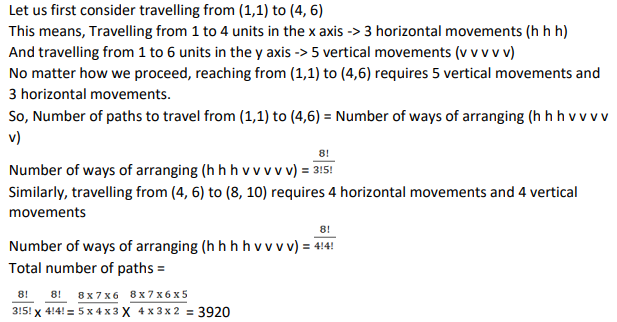
A club has 256 members of whom 144 can play football, 123 can play tennis, and 132 can play cricket. Moreover, 58 members can play both football and tennis, 25 can play both cricket and tennis, while 63 can play both football and cricket. If every member can play at least one game, then the number of members who can play only tennis is
Video Explanation

Explanatory Answer
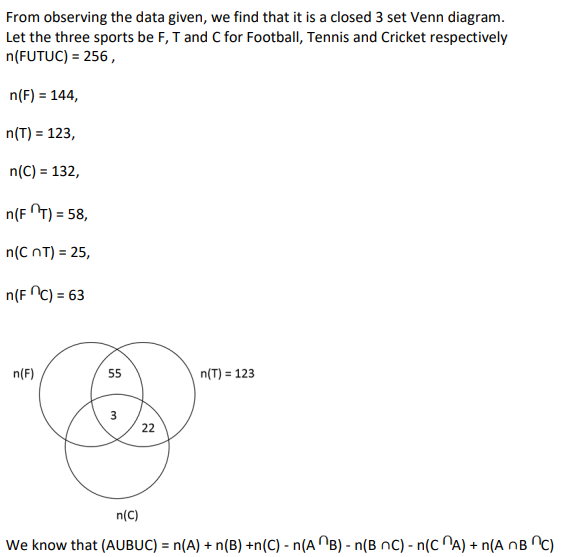

In a circle of radius 11 cm, CD is a diameter and AB is a chord of length 20.5 cm. If AB and CD intersect at a point E inside the circle and CE has length 7 cm, then the difference of the lengths of BE and AE, in cm, is
Video Explanation

Explanatory Answer
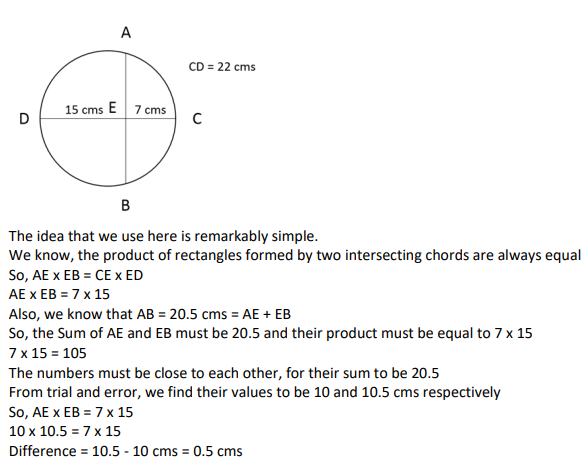
Meena scores 40% in an examination and after review, even though her score is increased by 50%, she fails by 35 marks. If her post-review score is increased by 20%, she will have 7 marks more than the passing score. The percentage score needed for passing the examination is
Video Explanation

Explanatory Answer
Meena scores 40 % in an exam
After review, she scores 50 % more => Increase of 50 % from 40 % = 40% + 20% = 60%
She fails by 35 marks, by scoring 60%
60% score = Pass mark - 35 ----- (1)
If her post review score is increased by 20%, she would have 7 more than the pass mark.
20% of 60% = 12 %
So, 60% + 12% = 72% of marks = Pass mark + 7 ------ (2)
So, 12% marks = 35 + 7 (5: 1 ratio)
So, similarly 12% can be re written as 10 % and 2 % (maintaining the 5:1 ratio)
Hence the pass percentage = 60 % + 10 % = 70%
(or)
Pass percentage = 72 % - 2 % = 70%
Corners are cut off from an equilateral triangle T to produce a regular hexagon H. Then, the ratio of the area of H to the area of T is
Video Explanation

Explanatory Answer
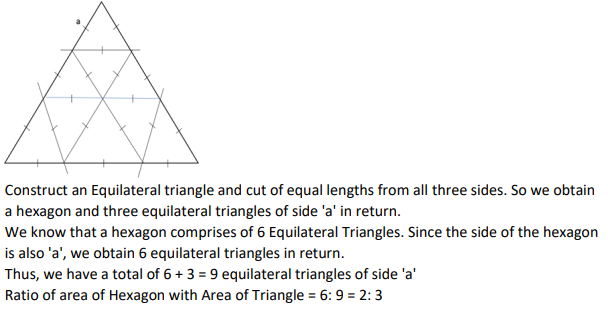
For any positive integer n, let f(n) = n(n + 1) if n is even, and f(n) = n + 3 if n is odd. If m is a positive integer such that 8f(m + 1) - f(m) = 2, then m equals
Video Explanation

Explanatory Answer
If n is even, f(n) = n (n + 1)
So, f (2) = 2(2+1) = 2 (3) = 6
If n is odd, f(n) = n + 3
f (1) = 1 + 3 = 4
It is given that, 8 x f(m+1) - f(m) =2
So, m can either be even or odd
Case-1: If m were even and m+1 odd
So, 8 x f(m+1) - f(m) =2
8(m + 4) - m (m + 1) = 2
8m + 32 - m2
- m = 2
m2
- 7m - 30 = 0
(m-10) (m+3) = 0
m = 10 or -3
m = 10, since m is positive
Case-2: If m were even and m+1 odd
8 x f(m+1) - f(m) =2
8 (m +1) (m + 2) - (m + 3) = 2
Now, let us substitute m = 1 which is the minimum possible value
8 (1 + 1) (1 + 2) - (1 + 3) 3
Case 2 does not work
Hence the answer is 10.
If the population of a town is p in the beginning of any year then it becomes 3+2p in the beginning of the next year. If the population in the beginning of 2019 is 1000, then the population in the beginning of 2034 will be
Video Explanation

Explanatory Answer
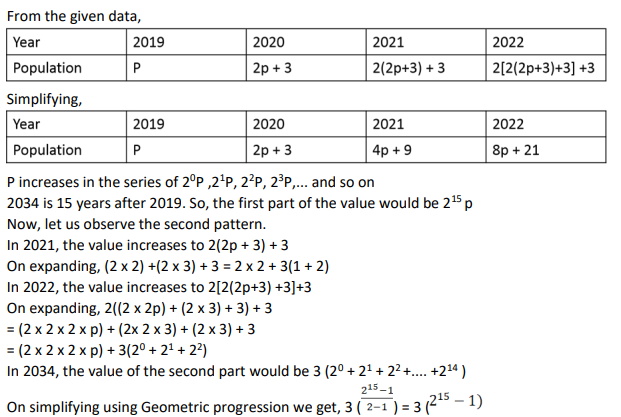

A person invested a total amount of Rs 15 lakh. A part of it was invested in a fixed deposit earning 6% annual interest, and the remaining amount was invested in two other deposits in the ratio 2 : 1, earning annual interest at the rates of 4% and 3%, respectively. If the total annual interest income is Rs 76000 then the amount (in Rs lakh) invested in the fixed deposit was
Video Explanation

Explanatory Answer
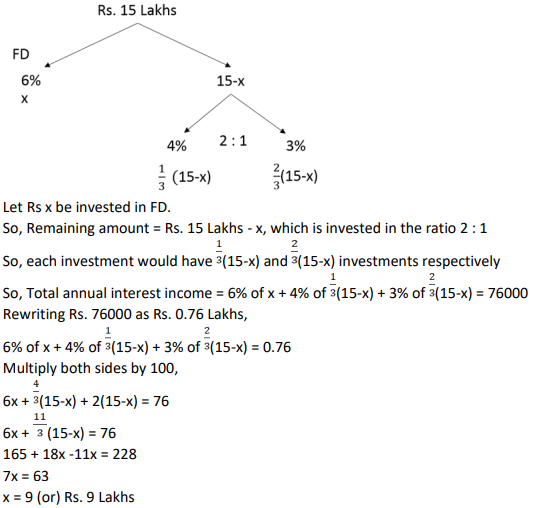
The product of two positive numbers is 616. If the ratio of the difference of their cubes to the cube of their difference is 157 : 3, then the sum of the two numbers is
Video Explanation

Explanatory Answer
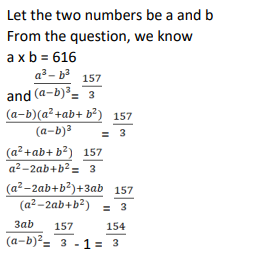
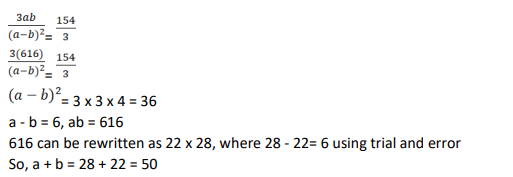
On selling a pen at 5% loss and a book at 15% gain, Karim gains Rs. 7. If he sells the pen at 5% gain and the book at 10% gain, he gains Rs. 13. What is the cost price of the book in Rupees?
Video Explanation

Explanatory Answer
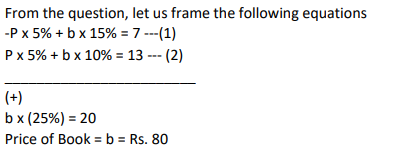
At their usual efficiency levels, A and B together finish a task in 12 days. If A had worked half as efficiently as she usually does, and B had worked thrice as efficiently as he usually does, the task would have been completed in 9 days. How many days would A take to finish the task if she works alone at her usual efficiency?
Video Explanation

Explanatory Answer

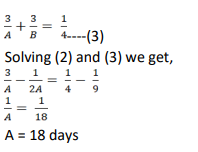
Two cars travel the same distance starting at 10:00 am and 11:00 am, respectively, on the same day. They reach their common destination at the same point of time. If the first car travelled for at least 6 hours, then the highest possible value of the percentage by which the speed of the second car could exceed that of the first car is
Video Explanation

Explanatory Answer
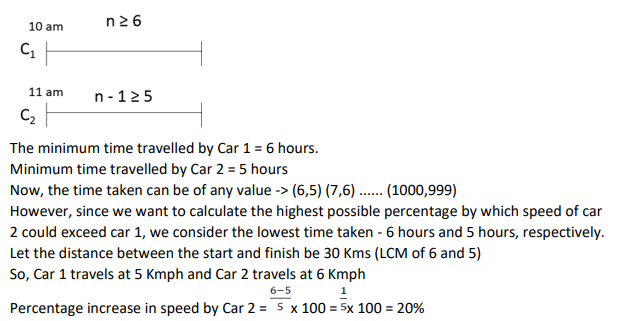
If a1 + a2 + a3 + . + an = 3(2n+1 - 2), then a11 equals
Video Explanation

Explanatory Answer

The number of the real roots of the equation 2cos(x(x + 1)) = 2x + 2-x is
Video Explanation

Explanatory Answer
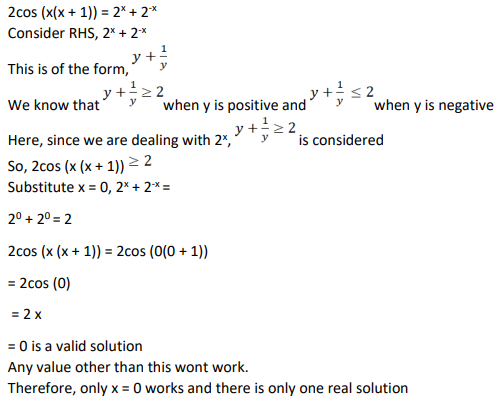
The income of Amala is 20% more than that of Bimala and 20% less than that of Kamala. If Kamala's income goes down by 4% and Bimala's goes up by 10%, then the percentage by which Kamala's income would exceed Bimala's is nearest to
Video Explanation

Explanatory Answer
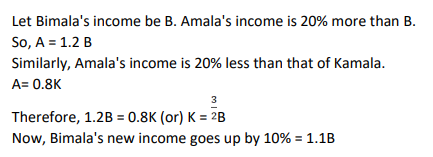
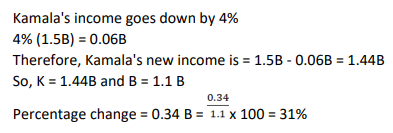
In a race of three horses, the first beat the second by 11 metres and the third by 90 metres. If the second beat the third by 80 metres, what was the length, in metres, of the racecourse?
Video Explanation

Explanatory Answer
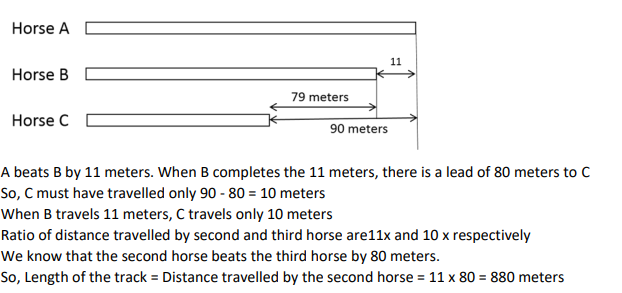
AB is a diameter of a circle of radius 5 cm. Let P and Q be two points on the circle so that the length of PB is 6 cm, and the length of AP is twice that of AQ. Then the length, in cm, of QB is nearest to
Video Explanation

Explanatory Answer
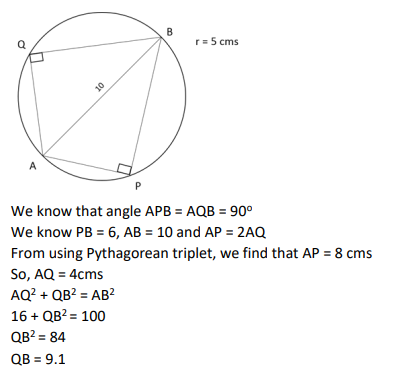
One can use three different transports which move at 10, 20, and 30 kmph, respectively. To reach from A to B, Amal took each mode of transport 1/3 of his total journey time, while Bimal took each mode of transport 1/3 of the total distance. The percentage by which Bimal's travel time exceeds Amal's travel time is nearest to
Video Explanation

Explanatory Answer
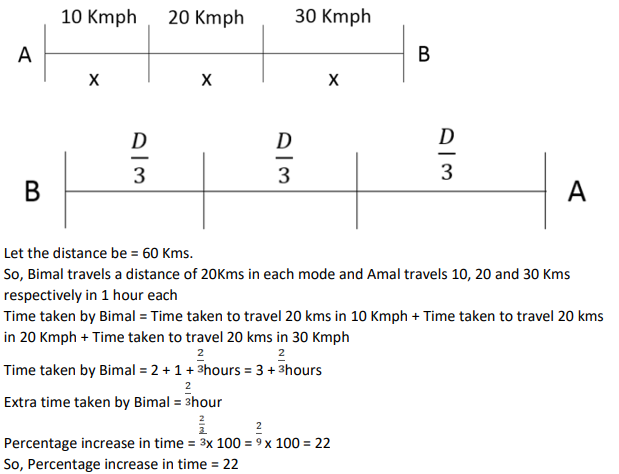
Amala, Bina, and Gouri invest money in the ratio 3 : 4 : 5 in fixed deposits having respective annual interest rates in the ratio 6 : 5 : 4. What is their total interest income (in Rs) after a year, if Bina's interest income exceeds Amala's by Rs 250?
Video Explanation

Explanatory Answer
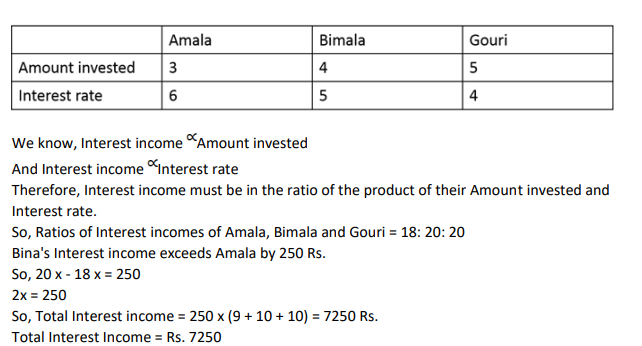
A chemist mixes two liquids 1 and 2. One litre of liquid 1 weighs 1 kg and one litre of liquid 2 weighs 800 gm. If half litre of the mixture weighs 480 gm, then the percentage of liquid 1 in the mixture, in terms of volume, is
Video Explanation

Explanatory Answer
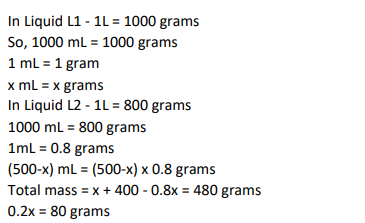

Let x and y be positive real numbers such that log5(x + y) + log5(x - y) = 3, and log2y - log2x = 1 - log23. Then xy equals
Video Explanation

Explanatory Answer
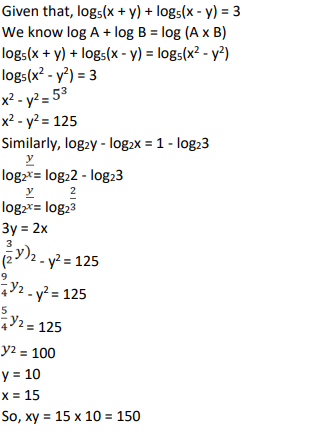
Let S be the set of all points (x,y) in the x-y plane such that |x| + |y| ≤ 2 and |x| ≥ 1. Then, the area, in square units, of the region represented by S equals
Video Explanation

Explanatory Answer
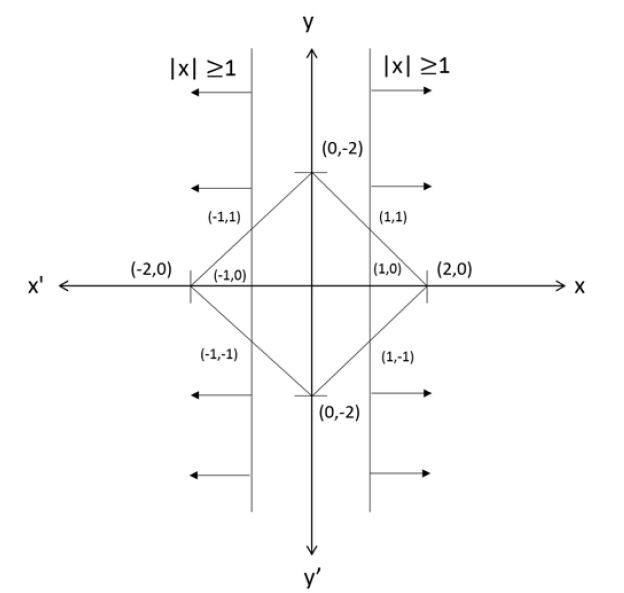


The number of solutions of the equation |x|(6x2 + 1) = 5x2 is
Video Explanation

Explanatory Answer
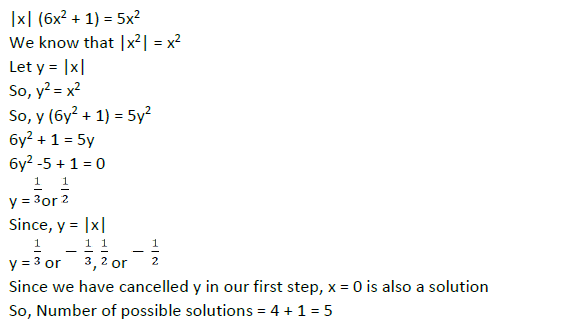
The product of the distinct roots of |x2 - x - 6| = x + 2 is
Video Explanation

Explanatory Answer
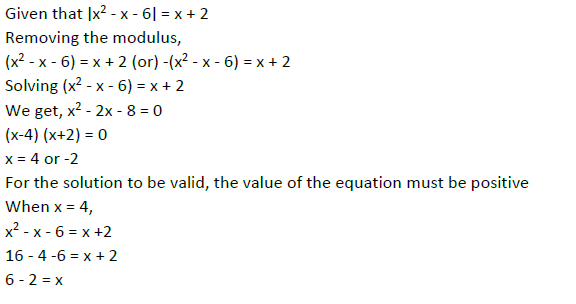
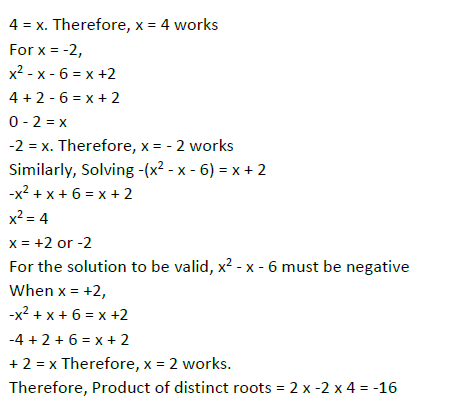
The wheels of bicycles A and B have radii 30 cm and 40 cm, respectively. While traveling a certain distance, each wheel of A required 5000 more revolutions than each wheel of B. If bicycle B traveled this distance in 45 minutes, then its speed, in km per hour, was
Video Explanation

Explanatory Answer
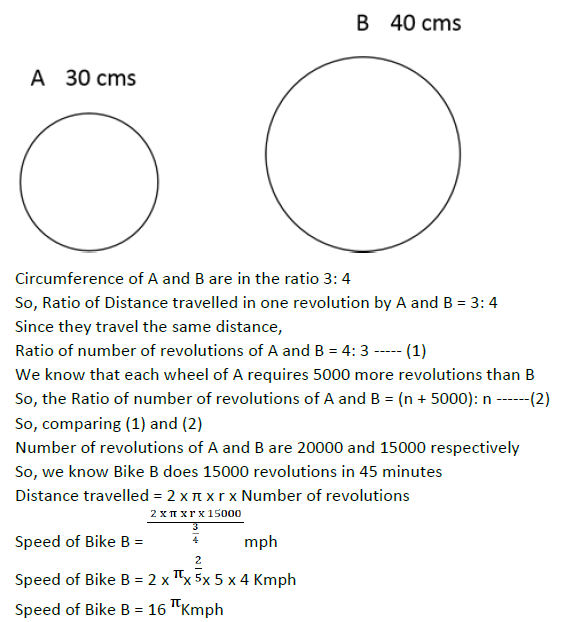
Consider a function f(x+y) = f(x) f(y) where x , y are positive integers, and f(1) = 2. If f (a+1) + f (a+2) + . + f(a+n) = 16 (2n - 1) then a is equal to
Video Explanation

Explanatory Answer
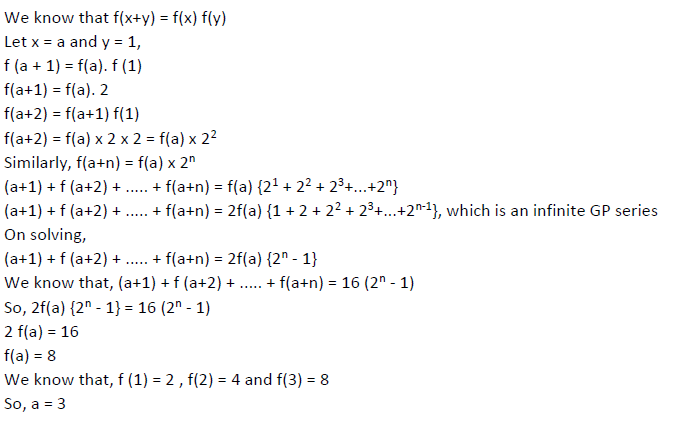
Ramesh and Gautam are among 22 students who write an examination. Ramesh scores 82.5. The average score of the 21 students other than Gautam is 62. The average score of all the 22 students is one more than the average score of the 21 students other than Ramesh. The score of Gautam is
Video Explanation

Explanatory Answer
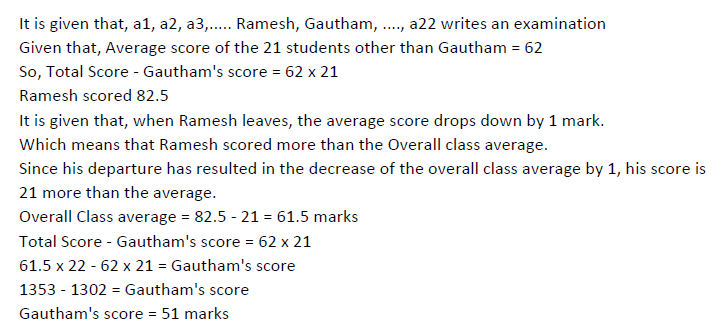
A new game show on TV has 100 boxes numbered 1, 2, ....., 100 in a row, each containing a mystery prize. The prizes are items of different types, a, b, c, ....., in decreasing order of value. The most expensive item is of type a, a diamond ring, and there is exactly one of these. You are told that the number of items at least doubles as you move to the next type. For example, there would be at least twice as many items of type b as of type a, at least twice as many items of type c as of type b and so on. There is no particular order in which the prizes are placed in the boxes
What is the minimum possible number of different types of prizes? ?
Video Explanation

Explanatory Answer
Minimum possible number is when there is 1 of type a and 99 of type b which is in accordance to the condition
What is the maximum possible number of different types of prizes?
Video Explanation

Explanatory Answer
Maximum possible number is when 1 of a, 2 of b, 4 of c, 8 of d, 16 of e, 32 of f,
Now left boxes would be 100 – (1+2+…32) = 37
Now if one more type is to be added then we need at least 64 which is not available thus maximum possible is 6.
Which of the following is not possible?
Video Explanation

Explanatory Answer
Let’s try to prove the given options possible using easy numbers.
op1:never possible
op2: 1,30,69 is possible
op3: 1,2,4,18.75 is possible
op4: 1,9,30,60 is possible.
You ask for the type of item in box 45. Instead of being given a direct answer, you are told that there are 31 items of the same type as box 45 in boxes 1 to 44 and 43 items of the same type as box 45 in boxes 46 to 100. What is the maximum possible number of different types of items?
Video Explanation

Explanatory Answer
There have to be then at least 31 + `1 + 43 = 75 gifts of same type, Thus maximum possible number of boxes = 5 when all types are lest 1,2,4,18,75
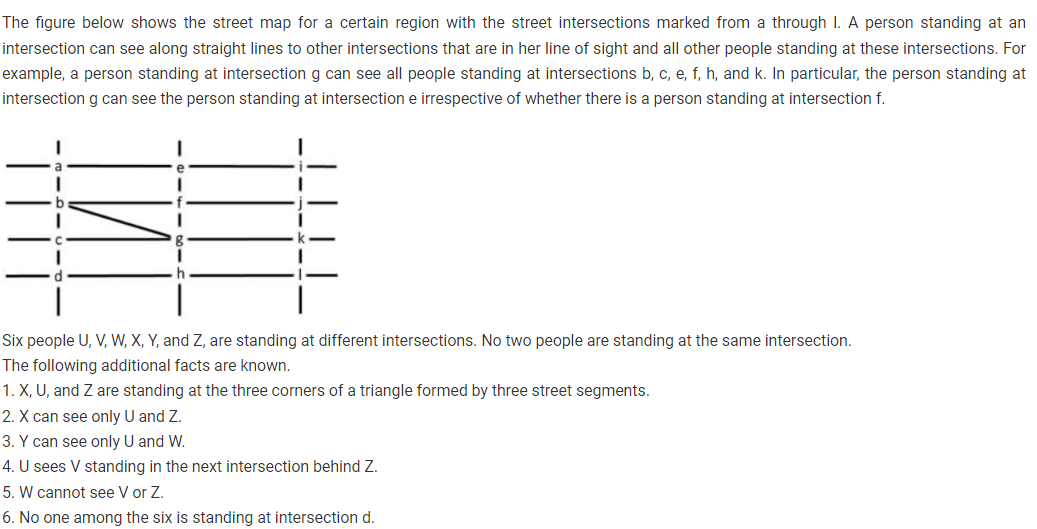
Who is standing at intersection a?
Video Explanation

Explanatory Answer
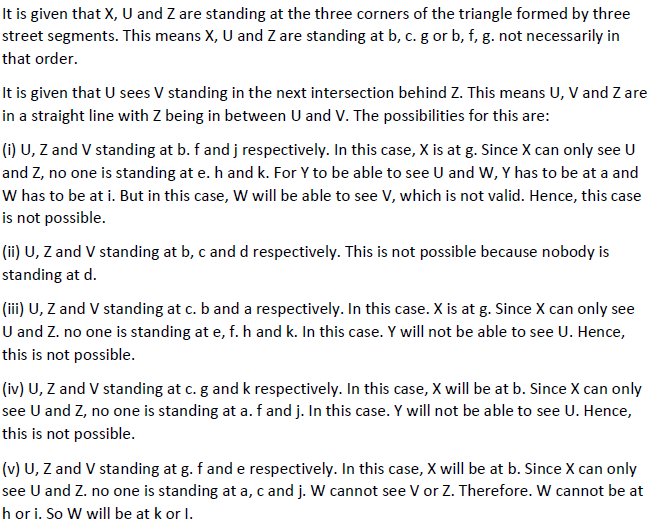
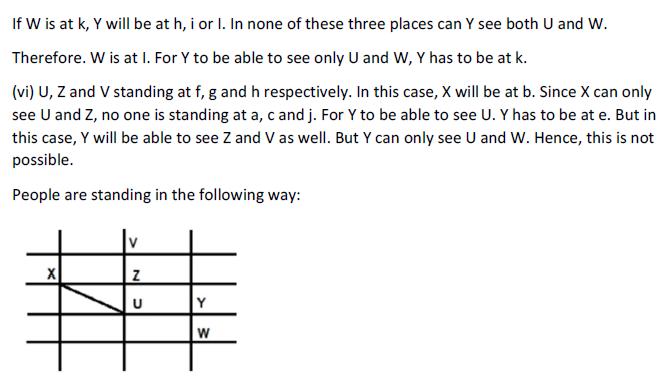
What is the minimum number of street segments that X must cross to reach Y?
Video Explanation

Explanatory Answer


Should a new person stand at intersection d, who among the six would she see?
Video Explanation

Explanatory Answer


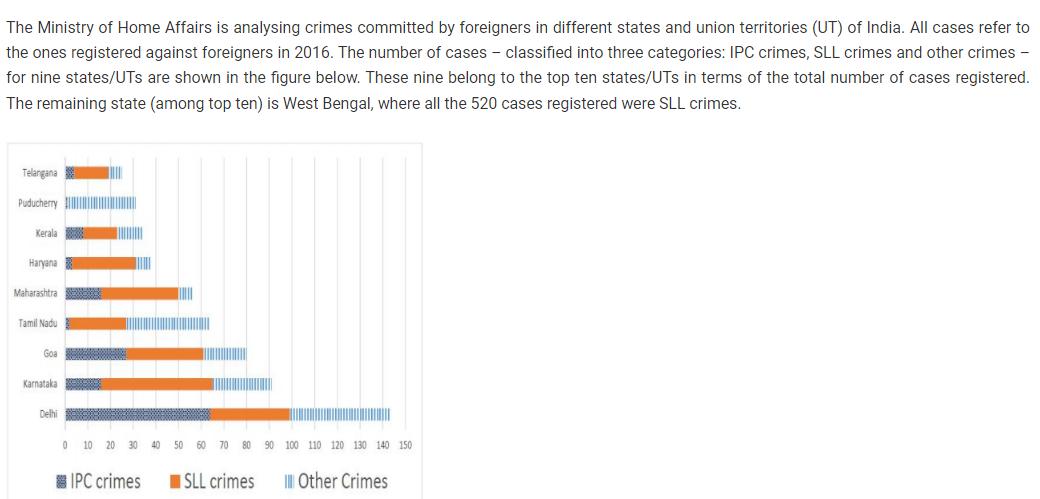
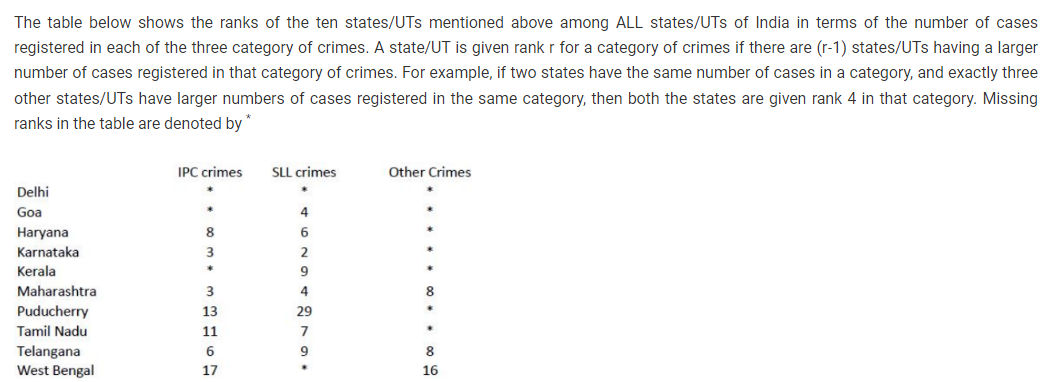
What is the rank of Kerala in the ‘IPC crimes’ category?
Video Explanation

Explanatory Answer
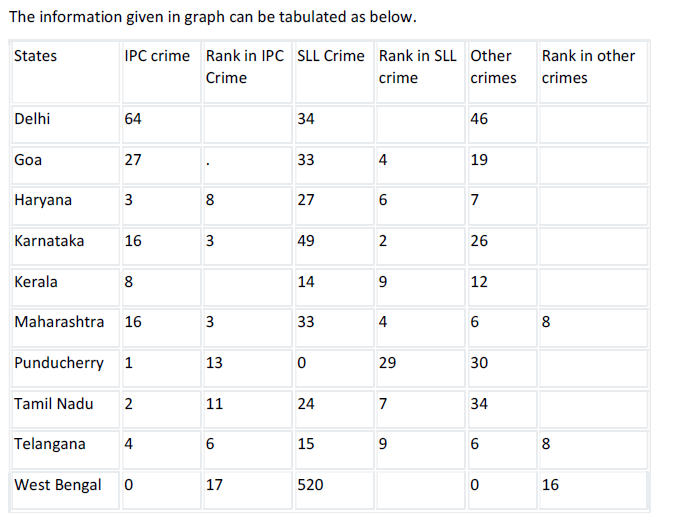
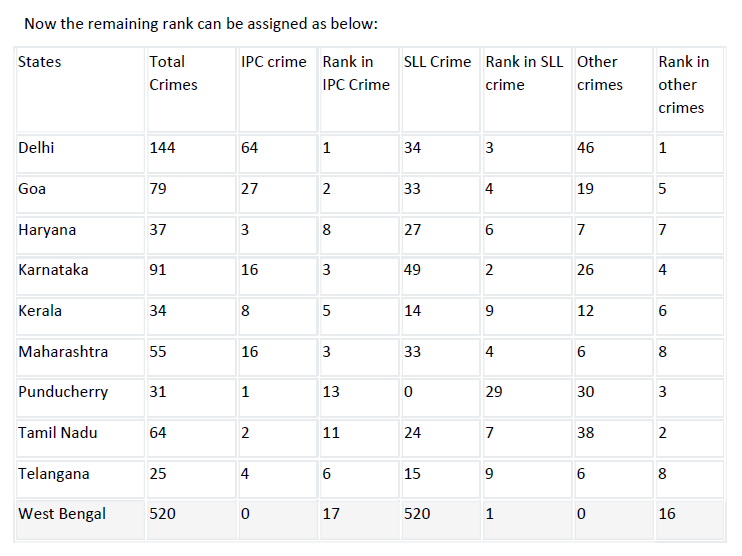

Which of the following is DEFINITELY true about the ranks of states/UT in the ‘other crimes’ category?
i) Tamil Nadu: 2
ii) Puducherry: 3
Video Explanation

Explanatory Answer



In the two states where the highest total number of cases are registered, the ratio of the total number of cases in IPC crimes to the total number in SLL crimes is closest to Ans :
Video Explanation

Explanatory Answer



What is the sum of the ranks of Delhi in the three categories of crimes?
Video Explanation

Explanatory Answer



Five vendors are being considered for a service. The evaluation committee evaluated each vendor on six aspects – Cost, Customer Service, Features, Quality, Reach, and Reliability. Each of these evaluations are on a scale of 0 (worst) to 100 (perfect). The evaluation scores on these aspects are shown in the radar chart. For example, Vendor 1 obtains a score of 52 on Reliability, Vendor 2 obtains a score of 45 on Features and Vendor 3 obtains a score of 90 on Cost
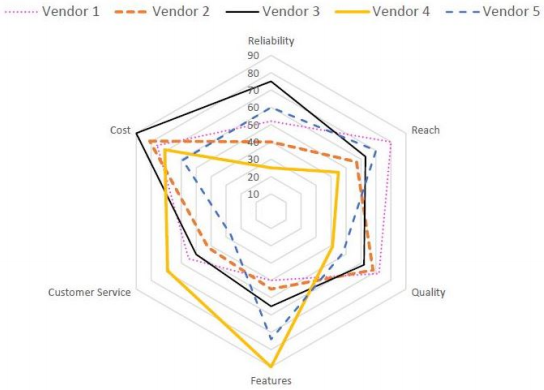
On which aspect is the median score of the five vendors the least?
Video Explanation

Explanatory Answer



A vendor's final score is the average of their scores on all six aspects. Which vendor has the highest final score?
Video Explanation

Explanatory Answer



List of all the vendors who are among the top two scorers on the maximum number of aspects is:
Video Explanation

Explanatory Answer



List of all the vendors who are among the top three vendors on all six aspects is:
Video Explanation

Explanatory Answer



A supermarket has to place 12 items (coded A to L) in shelves numbered 1 to 16. Five of these items are types of biscuits, three are types of candies and the rest are types of savouries. Only one item can be kept in a shelf. Items are to be placed such that all items of same type are clustered together with no empty shelf between items of the same type and at least one empty shelf between two different types of items. At most two empty shelves can have consecutive numbers.
The following additional facts are known.
1. A and B are to be placed in consecutively numbered shelves in increasing order.
2. I and J are to be placed in consecutively numbered shelves both higher numbered than the shelves in which A and B are kept.
3. D, E and F are savouries and are to be placed in consecutively numbered shelves in increasing order after all the biscuits and candies.
4. K is to be placed in shelf number 16.
5. L and J are items of the same type, while H is an item of a different type.
6. C is a candy and is to be placed in a shelf preceded by two empty shelves.
7. L is to be placed in a shelf preceded by exactly one empty shelf.
In how many different ways can the items be arranged on the shelves?
Video Explanation

Explanatory Answer
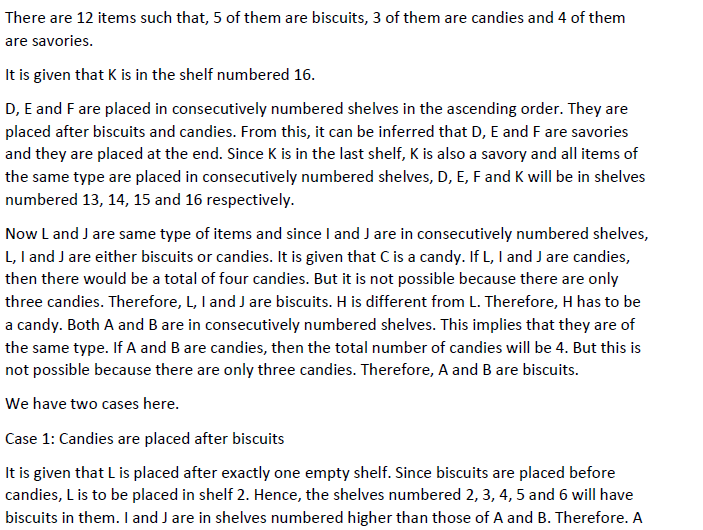
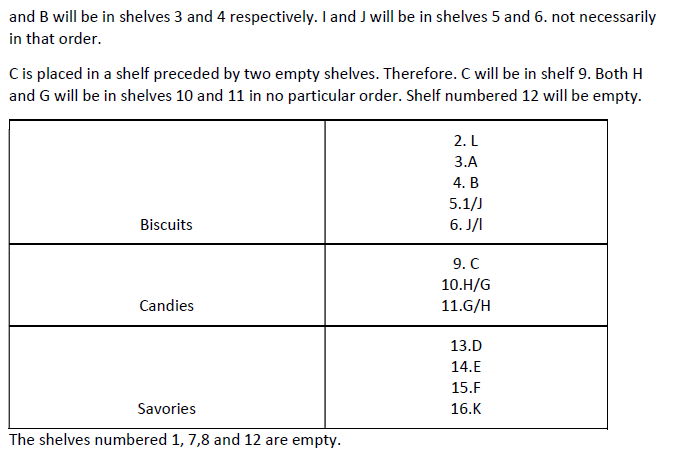
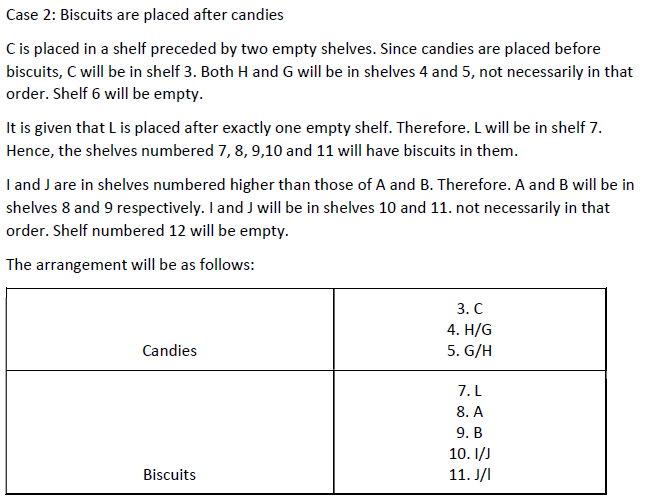

Which of the following items is not a type of biscuit?
Video Explanation

Explanatory Answer




Which of the following can represent the numbers of the empty shelves in a possible arrangement?
Video Explanation

Explanatory Answer




Which of the following statements is necessarily true?
Video Explanation

Explanatory Answer




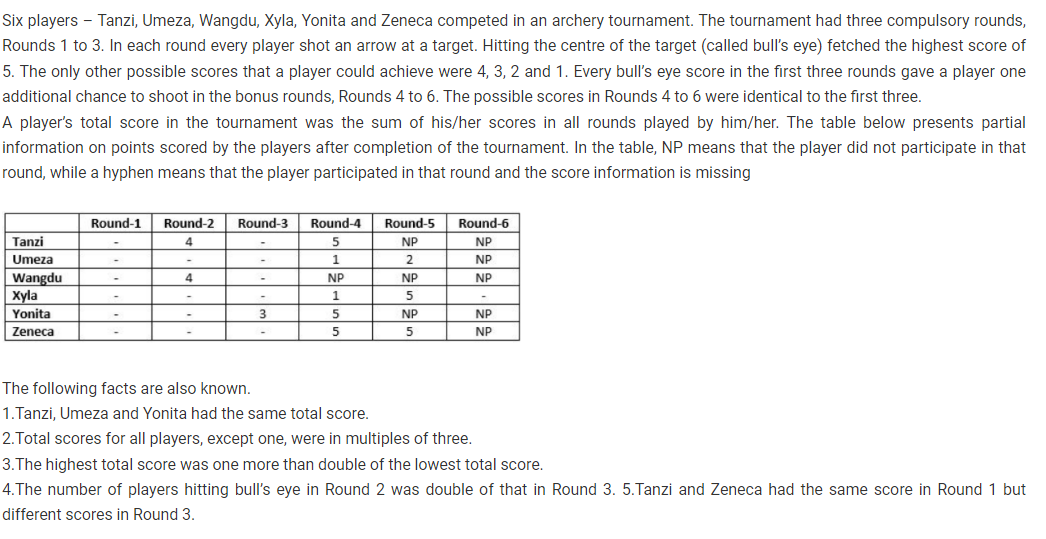
What was the highest total score?
Video Explanation

Explanatory Answer
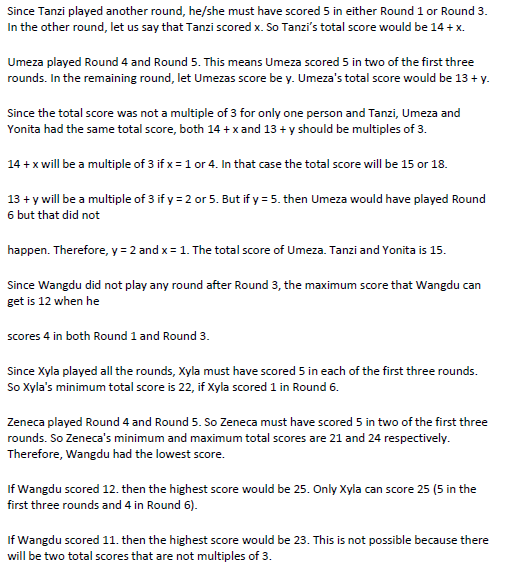
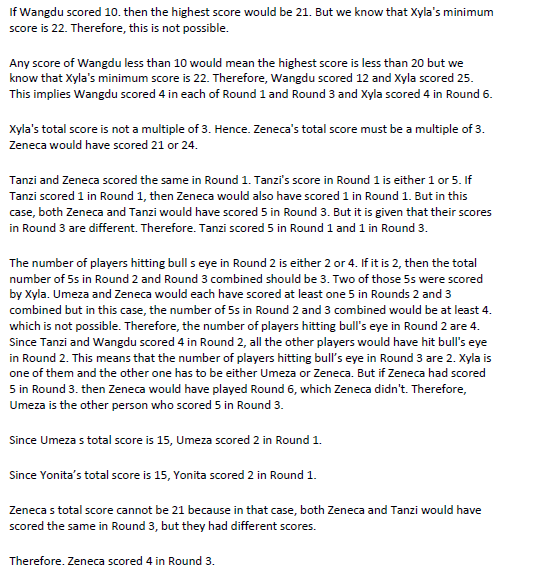
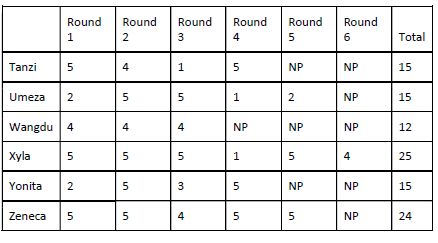
Which of the following statements is true?
Video Explanation

Explanatory Answer



What was Tanzi's score in Round 3?
Video Explanation

Explanatory Answer











